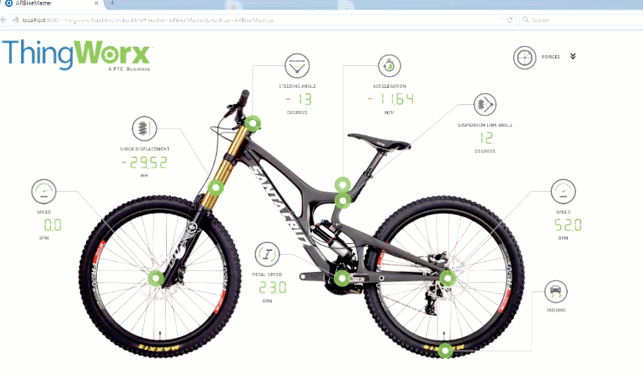The Internet of Things (IoT) is the new hot topic in the technology world. Al Dean has been struggling to think of a way it might benefit the design process, and he may have finally found it…strapped to a mountain bike in Boston

Figure 1
If there’s one thing that the technology industry loves, it’s a new three-letter acronym. It gives the techies something to rally around, something to tout as the next big thing, something around which they can inflate a great big bubble.
Over the past couple of years, the Internet of Things, or IoT, has been the new hot shit in the tech world. But the issue, for me at least, has always been the nebulous nature of the term.
IoT is one of those concepts that means different things to different people. Few can express clearly what it means, without delving into specifics, with an inevitable bias in their own company’s favour.
So if you’re in the refrigerator business, it’s about building a fridge that can tell a customer when they run out of milk or even automatically order fresh milk from an online grocery store — apparently.
But as with all things in technology, if you’re prepared to pop the bubble and dig a bit deeper, you’ll usually uncover what it actually means.
The IoT is, at a base level, about connected devices: machines that use the internet to convey information — either to other machines, to the user or to the original manufacturer of that machine.
It’s the wristband that tracks your running. It’s the fancy new thermostat in your home, bristling with sensors and designed by a guy who once worked at Apple.

Figure 2
It’s the industrial earth-moving equipment that detects when it’s due for a service, and alerts not only the construction boss, but also the third-party mechanics who carry out repairs.
Until recently, I’ve struggled with how all this could be of benefit to the design process. More specifically, I’ve been wondering what mileage there might be here for using this type of technology in new product development?
Surely, given a set of smart sensors that connect back to a centralised point and some tools to aggregate the stream of data they generate, we could use IoT as part of the design/test/break/design cycle?
So it was with some surprise and actual glee (and it takes a lot to generate that emotion in me these days) that I saw the perfect demonstration of exactly that thinking at PTC’s recent LiveWorx event, held in Boston.
LiveWorx was PTC’s first event for a market segment in which it’s been making acquisitions for the last year or two (to the tune of half a billion dollars, I might add) and it was clear from the start that the team was out to impress.
The demonstration drew together PTC’s IoT technology (ThingWorx) which connects an organisation to all manner of data, streamed from any form of device, as well as PTC’s own 3D CAD experience (in the form of Creo, of course) and some surprisingly cheap sensors — oh, and a Santa Cruz mountain bike.

Figure 3
The team demonstrated a technology concept it calls the ‘Digital Twin’. Essentially, they rigged the bike with sensors and streamed the data over the internet, via a Raspberry Pi or two (see Figure 1).
ThingWorx then took the data and transformed it into a dashboard that allows the user to monitor those sensors’ real-world output, measuring speed, shock displacement, steering angle, movement of the suspension arm at the rear and pedal speed (see Figure 2).
It then pushed that data, live, to a Creo session that mimicked the same movement, creating the digital twin. As the bike moved, so the Creo model updated (Figure 3).
And to cap it all off, the PTC team also developed an augmented reality app for the iPad, which overlays the same information on a live video stream when the tablet is pointed at the bike (see Figure 1).
It was truly remarkable to see on show such a well thought-out concept. It certainly got my brain (and those of other attendees) working overtime.
Just think for a minute what was achieved here. Think what it might be achieved in future. Then carry on thinking, when I tell you that the whole project cost PTC just $300 and took two days’ work.
Could the hot new technology make life easier in new product development?
Default






